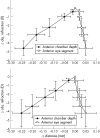Linear relationship of refractive and biometric lenticular changes during accommodation in emmetropic and myopic eyes
- PMID: 17050582
- PMCID: PMC1857649
- DOI: 10.1136/bjo.2006.099879
Linear relationship of refractive and biometric lenticular changes during accommodation in emmetropic and myopic eyes
Abstract
Aim: Aim of this study was to investigate the relationship between refractive changes in the eye and biometric changes of the human crystalline lens during accommodation. Furthermore, differences in these relationships between young, healthy emmetropic and myopic subjects were analyzed.
Methods: Mean relative change in anterior chamber depth (ACD), lens thickness (LT), anterior segment length (ASL = ACD + LT) and in objective refraction were simultaneously assessed during near-point-induced accommodation in 10 emmetropic and 10 myopic subjects. Via a beam splitter, measurements were performed simultaneously using partial coherence interferometry (PCI) and infrared (IR) photorefraction.
Results: On average, for each diopter of accommodation LT increased by 0.063 mm in emmetropic and by 0.072 mm in myopic eyes, and ACD decreased by 0.047 mm and 0.057 mm, respectively. Mean ASL, indicating the position of the posterior lens pole, increased by 0.009 mm in emmetropic and by 0.013 mm in myopic eyes. The correlation between refractive and biometric changes was found to be essentially linear in both subgroups. Differences in ACD between emmetropic and myopic eyes were statistically significant at an accommodative stimulus of -1 D (p<0.04) and -2 D (p<0.02).
Conclusion: The biometric and refractive changes of the human lens are highly correlated and linear in function in both emmetropic and myopic eyes.
Conflict of interest statement
Competing interests: WD is a consultant to Carl Zeiss Meditec AG. No other author has a proprietary or financial interest in any material or method mentioned.
References
-
- Findl O. Intraocular lenses for restoring accommodation: hope and reality. J Refract Surg 200521321–323. - PubMed
-
- Glasser A, Campbell M C. Biometric, optical and physical changes in the isolated human crystalline lens with age in relation to presbyopia. Vision Res 1999391991–2015. - PubMed
-
- Vilupuru A S, Glasser A. Dynamic accommodation in rhesus monkeys. Vision Res 200242125–141. - PubMed
-
- Vilupuru A S, Glasser A. Dynamic accommodative changes in rhesus monkey eyes assessed with A‐scan ultrasound biometry. Optom Vis Sci 200380383–394. - PubMed
MeSH terms
LinkOut - more resources
Full Text Sources
Miscellaneous



